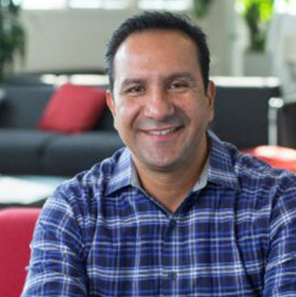Shawnna Sumaoang: Hi, and welcome to the Sales Enablement PRO podcast. I am Shawnna Sumaoang. Sales enablement is a constantly evolving space, and we are here to help professionals stay up to date on the latest trends and best practices so they can be more effective in their jobs.
Thank you so much for joining us today. I would love for you to take a moment and just introduce yourself, your title, and your organization.
Edwin Castillo: Yeah, absolutely. So, I recently joined 8×8. I am the new global VP for enablement, and that actually covers sales, our channel, and our customer and end-users.
SS: Awesome, well, congratulations on your new role! I’d love for you to tell us about your experience in sales enablement. How long have you been doing enablement and how did you get to where you are today?
EC: Yeah, absolutely. So, I’ve been in sales enablement for a little over 20 years, and my career actually started in the legal field. So, out of law school, I practiced business litigation for a couple of years and joined PeopleSoft before they were acquired by Oracle as corporate counsel in the West region. From there, I moved into biz dev at PeopleSoft and my career in sales sort of started at that point, the transition into sales.
Our region in the West was probably one of the strongest in terms of production and discounting and actually in terms of the lowest churn in the company. Part of that was because we sold deals that represented a really high value to our customers, and at the time there wasn’t much training being offered to sales, other than outside programs from the skills perspective, and product training in terms of helping them understand how the product works.
Along with four different pillars – PeopleSoft had HCM, financial, CRM, and supply chain – one of the asks from our then-CEO was for me to travel around to the different regions and talk about how we accomplish that in terms of not giving into discounting, in terms of making sure that our sales were adding value for our customers. One thing led to another and I actually started our first-ever global training department at PeopleSoft. So, I transitioned from legal counsel to biz dev to actually heading up our training, global training, and I never looked back. In fact, that’s where my career started.
When we were acquired by Oracle back in 2004 and moved to one of our biggest customers at the time, Kaiser Permanente, I ran all of the learning and organizational development. So, that spanned not just our go-to-market sales and account management functions, but it also included our underwriting, pricing, marketing, etc. That was a big career shift for me in terms of going from just interacting purely with sales to now interacting in, working with, and enabling our entire go-to-market function within that insurance business. I think the total population at the time was around 1,700, and in that business unit with obviously Kaiser having about 200,000 employees nationwide.
I missed technology, and after three years at Kaiser, I jumped back in and went to Salesforce.com. At, Salesforce, I started our Salesforce University, which I’m proud to say went from the five people that I hired at the time back in 2007 to about 150 people now. That began sort of not just sales enablement, but I also was working with our customer training admin certification groups and trying to monetize training. That became a really self-sustaining business. I think in our first year, it was generating about two to $3,000,000 in revenue, and now it’s close to $500,000,000 in revenue.
So, I have enjoyed it. I mean, it’s been a highly rewarding career move for me. I think that, you know, sales has evolved, as you said in your intro. Sales enablement has evolved. It’s gone from pure training to all sorts of aspects around performance management, coaching, career development, onboarding, etc. I’ve thoroughly enjoyed the 20 years that I’ve spent in sales enablement.
SS: You definitely have a unique background coming out of law school and starting with training. I think a lot of organizations, when they begin their journey with sales enablement, they definitely start there. You started to allude to this, the evolution of sales enablement, but how have you seen sales enablement evolve over the years and where do you see it going in the future?
EC: I think sales enablement, when you think about some of the practical tangible tasks that sales enablement has been made responsible for, it’s mostly around training. It’s around training on messaging, training on product, helping new hires learn how to sell that company’s products and solutions. Where I think sales enablement is going is more around deal coaching –deal coaching and partnering more closely with HR and with marketing.
With HR, on performance management, because a lot of times a company will hire sales reps with all the different types of background, experience, and proficiency, and they’re not necessarily measured all the same, with the exception of their quotas. So, what I mean by that is that you’ll have someone who’s a really strong closer, you have someone who’s really strong at discovery, someone else who’s highly organized, and then you have a couple of others who are extremely disorganized.
So, it’s impossible to actually say, here’s a quota, all things being equal, good luck. Once we train you on how to message and perhaps roll out some kind of skills training methodology, there has to be specific coaching that is custom to those individuals. Sometimes it’s even more difficult for the managers to be able to do that when he or she is responsible for a number and is moving from deal to deal to help those deals get pushed through, which is sort of how they got their jobs in the first place, because they’re really good at sales.
Sales enablement can play a major role in helping all those different individuals with different needs, strengths, and weaknesses be able to succeed. It’s by adjusting how they actually coach and reinforce some of the programs that they initially put together. More and more, I see folks who are successful in sales enablement in that they’re really more in touch with the field and they’re working side by side with managers and side by side with HR in terms of how to do performance management, essentially, how to drive performance.
The other partnership that I talked about is working closely with product marketing because a lot of times, product marketing will put together a great number of tools and assets around messaging. A lot of them resonate with existing customers or with analysts, but they’re not necessarily geared toward the individual buyers. What I mean by that is they’re not really persona-driven. What I’ve noticed more and more is product marketing trying to focus on different personas and how their products actually help those personas. And what’s important about that is that the messaging has to resonate with the buyer and it has to resonate with where we’re guiding our sales reps to go focus.
So, it’s a mixed message if we’re telling our reps to go hire an organization to talk to VPs and directors. Yet, the messaging that we’re giving them is for the end-user or for an analyst. Then, they’re creating their own questions to go ask and a lot of times, it’s fallen on deaf ears. That’s where buyers are like, “I’m not really interested” or “this doesn’t make sense.” The more and more product marketing gears its message towards the actual buyer, the actual persona-level within the organization, the more equipped sales is.
Then, sales enablement having responsibilities around educating and getting that message out to reps can then go in and help coach them to make sure they’re asking the right questions, they’re talking to the right people, and work side by side with sales management to make sure that team is producing at a high level.
SS: Absolutely, absolutely. So, at the Soirée last year, you talked about the need for sales enablement to actually have a seat at the table during pipeline and sales productivity meetings. In your opinion, why is that so important?
EC: I think it’s important for sales enablement to have a seat at the table in terms of goal setting and forecasting, and in actually looking at where companies, departments, geographies are hitting the mark or missing the mark. Because that’s where prioritization or priorities get established. I think if sales enablement is hearing second-hand that we’re missing our number, we need to go drive sales along with this particular product line, they’re not really hearing or they’re not able to contribute to how those priorities get established and measured. Especially if they’re actually the ones that are sitting with the sales rep and helping them understand the message and helping them understand the questions to ask and how to really manage that deal and move that deal cycle forward.
So, the more engaged sales enablement is with prioritization, with the identification of gaps that a company has in terms of trying to get deals across the finish line, as well as which products in which geographies are challenging, the better they’re able to help the salesforce execute against those.
SS: On the topic of measurement, since you brought it up, what metric should sales enablement be responsible for in order to demonstrate their business impact?
EC: I think first and foremost, it’s revenue. Revenue is the number one indicator of success for any company, whether public or private. And behind that is repeatable revenue, so the ability to consistently hit a number and grow that number. So, knowing that revenue is important.
But revenue sometimes is a lagging indicator, because you don’t measure it until it comes in. The things that sales enablement needs to focus on in order to achieve that revenue number are the things that lead up to that revenue attainment. And those things are pipeline growth.
Strong pipeline versus weak pipeline, meaning you know having deals with the right personas established to go after. A pipeline that’s filled with high profile or high probability customers, which means like customers that the company wants to do business with versus just random companies in the pipeline with either no possibility of doing business with that company or not a company that the organization wants to close as a customer.
Then the other indicator that I think is really important is activity, a level of activity. You can now measure within Salesforce how many contacts a sales rep has and how often the sales rep is engaging with them. There’s AI software that can actually go and scrape Salesforce and the local intranet or the companies’ email servers and be able to provide an answer on how many people that rep has e-mailed and how many people have e-mailed him or her back, and how long those conversations have been, and how frequent. So, that activity-based measurement is another leading indicator of success in terms of revenue attainment. I think those two are probably the biggest.
And then there are others that traditionally have shown that a rep understands how to successfully sell, and that’s their certification on delivering the pitch deck, delivering an elevator pitch, showing the company that he or she successfully understands a methodology and can navigate a deal through the sales process. I think those are more tactical than strategic or leading indicators, but I would say those three are probably the most relevant in terms of leading up to that one true measurement of success — which is revenue.
SS: As the sales enablement function evolves, do you see the success metrics changing much?
EC: That’s a great question. I think the other things that will come into play as we get into an even more competitive market, competitive for talent as well, is career progression for SDRs and AEs, retention of those resources, and employee satisfaction. I think you could do all the things we talked about earlier, but if you are constantly losing good people, it makes it challenging to then go back and have to retrain or re-enable those new hires to be able to get to where the folks are that you lost.
So, that’s another thing that I haven’t talked about, and that’s I think sales enablement also needs a seat at the table because the sales enablement function can have a positive or negative impact on the culture of sales and the culture of the organization.
SS: I absolutely think that’s critical in today’s sales talent market, especially with unemployment at an all-time low. And finding great sales talent is a hard thing to do, absolutely. So, last question for you, because beyond being a sales enablement practitioner you also have a background in consulting and advising. So, how has that experience influenced your approach to sales enablement?
EC: I think it’s impacted my approach in a big way. I think the main reason is that as a consultant, I’m constantly working to solve a problem or solve a series of problems, and I think that is a best practice approach for sales enablement. A lot of times, people are hired into sales enablement role and are waiting to hear what their mandate is versus seeking to solve the problems that the sales organization has. If you go into it, and I teach this to salespeople all the time, if you go into an organization and you go in looking to help them to solve a problem, become a trusted advisor (I know it is cliché, but it’s so true), become that added value consultant, you take a different approach.
Your questions are more genuine and relevant, and you’re seeking to learn to see whether or not you can help. I think as a consultant, one of the things I learned is that everybody has a different need, different problem, different background, different perspectives. It’s my job to understand what their problem is, and how they’re looking at that problem, and how they’re looking to solve for it, because they’ve got a whole different environment than others. So, they may have a brand-new salesforce and a very weak manager and a really strong product. Or, it could be the complete opposite: the product is not as good, it needs to get better, but their sales team is really strong, they’re very seasoned, they’re frustrated, they might leave, but we need to give them some incentive to stay.
So, the approach to solving the problem of generating revenue using the team that they’ve got is going to be really different. How that leader or that group of leaders is trying to solve it is going to be important. Then, we can attack the solution as opposed to, “hey, tell me who I need to train and tell me what things I need to check off so that I can show my value to the organization as a sales enablement professional or sales trainer,” which I think is noble, but really not a true value add.
SS: Absolutely. That’s absolutely true. Well, thank you so much, Edwin, I really appreciate your time today.
EC: You’re very welcome.
SS: To our audience, thanks for listening! For more insights, tips, and expertise from sales enablement experts please visit salesenablement.pro if there’s something you’d like to share or a topic you want to learn more about, please let us know. We’d love to hear from you.







